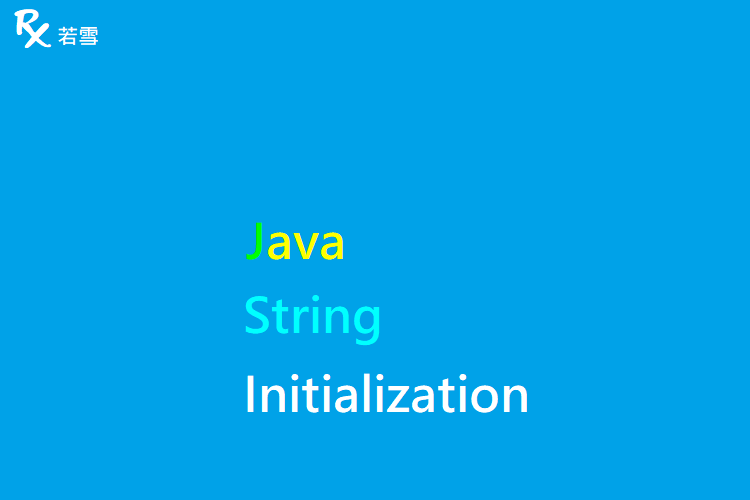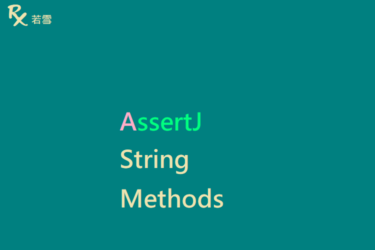Table of Contents
ToggleJava String Initialization
字串初始化的方式,在 Java 中,字串是不可變的物件,一旦建立後就不能改變,使用 new 關鍵字建立字串,在這種情況下,JVM 將在普通堆記憶體中建立一個新的字串物件,並且文字將被放置在字串池中,變數將引用堆中的物件, String Java Initialization 初始化字串,本篇增加了範例,並透過單元測試來驗證產出結果。
檔案目錄
./
+- src
+- test
| +- org
| +- ruoxue
| +- java_147
| +- string
| +- StringInitializationTest.java
單元測試
Initialization of String 提供初始化建立字串。
withLiteral
使用文字,建立一個 String 。
@Test
public void withLiteral() {
String value = "Assertj";
System.out.println(value);
assertEquals("Assertj", value);
String value2 = "155";
System.out.println(value2);
assertEquals("155", value2);
}Assertj
155withNew
Initialization of String 使用 new 關鍵字,建立一個 String 。
@Test
public void withNew() {
String value = new String("Assertj");
System.out.println(value);
assertEquals("Assertj", value);
String value2 = new String("155");
System.out.println(value2);
assertEquals("155", value2);
}Assertj
155withByteArray
Initialization of String 使用 byte 陣列,建立一個 String 。
@Test
public void withByteArray() {
byte[] value = new byte[] { 65, 115, 115, 101, 114, 116, 106 };
String result = new String(value);
System.out.println(result);
assertEquals("Assertj", result);
byte[] value2 = new byte[] { 65, 115, 115, 101, 114, 116, 106, 32, 49, 53, 53 };
String result2 = new String(value2, 8, 3);
System.out.println(result2);
assertEquals("155", result2);
}Assertj
155withCharArray
Initialization of String 使用 char 陣列,建立一個 String 。
@Test
public void withCharArray() {
char[] value = new char[] { 'A', 's', 's', 'e', 'r', 't', 'j' };
String result = new String(value);
System.out.println(result);
assertEquals("Assertj", result);
char[] value2 = new char[] { 'A', 's', 's', 'e', 'r', 't', 'j', ' ', '1', '5', '5' };
String result2 = new String(value2, 8, 3);
System.out.println(result2);
assertEquals("155", result2);
}Assertj
155intStream
Initializing Stream in Java 建立一個 IntStream ,初始化三個元素。
@Test
public void intStream() {
int expectedCount = 3;
IntStream intStream = IntStream.of(10, 20, 30);
long count = intStream.peek(System.out::println).count();
assertEquals(expectedCount, count);
}Assertj
155StringInitializationTest.java
Initializing String in Java 新增單元測試,驗證是否符合預期。
package org.ruoxue.java_147.string;
import static org.junit.Assert.*;
import org.junit.Test;
public class StringInitializationTest {
@Test
public void withLiteral() {
String value = "Assertj";
System.out.println(value);
assertEquals("Assertj", value);
String value2 = "155";
System.out.println(value2);
assertEquals("155", value2);
}
@Test
public void withNew() {
String value = new String("Assertj");
System.out.println(value);
assertEquals("Assertj", value);
String value2 = new String("155");
System.out.println(value2);
assertEquals("155", value2);
}
@Test
public void withByteArray() {
byte[] value = new byte[] { 65, 115, 115, 101, 114, 116, 106 };
String result = new String(value);
System.out.println(result);
assertEquals("Assertj", result);
byte[] value2 = new byte[] { 65, 115, 115, 101, 114, 116, 106, 32, 49, 53, 53 };
String result2 = new String(value2, 8, 3);
System.out.println(result2);
assertEquals("155", result2);
}
@Test
public void withCharArray() {
char[] value = new char[] { 'A', 's', 's', 'e', 'r', 't', 'j' };
String result = new String(value);
System.out.println(result);
assertEquals("Assertj", result);
char[] value2 = new char[] { 'A', 's', 's', 'e', 'r', 't', 'j', ' ', '1', '5', '5' };
String result2 = new String(value2, 8, 3);
System.out.println(result2);
assertEquals("155", result2);
}
}
心得分享
Java Initializing String 一般而言有幾種 String 初始化的操作, Initializing String in Java 提供了例如: new 、 byte[] 、 char[] 初始化方式,在應用上相當廣泛。




